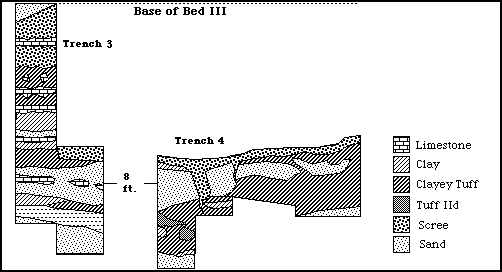
Click on the stratum key at right for more information about each stratum.

This page provides you with information on the stratigraphy of Site BK at Olduvai Gorge. In general, the deposits have been so heavily reworked and moved about by subsequent stream action, that they have been treated as a single depositional period. It is evident that the material was laid down during a period of significant rainfall, at a time when the lake level was still fairly high, giving rise to swampy areas such as this one was. It would have been a good location for traping medium to large game in the soft river and lake muds. Substantial deposits of large antelope bone and remains of other animals internedded with stone tools lends some credibility to this notion.
Profile Drawings - BK Site Model
The scree that proliferates at Site BK is coarse erosional material from the surrounding canyon walls. It is heavily reworked and forms a fairly continuoud blanket over the lower deposits. In most places, the scree forms the modern land surface.
The sands found in the deposits at Site BK are of two types. There are thick-bedded water lain sands indicating periods of slow stream flow. Interbedded with these and the clays are beds of sands that display evidence of having been bedded by current activity, during periods of faster stream flow.
The limestone that occurs in the deposits at site BK consist of large and small blocks eroded from the surrounding gullies and deposited by stream action.
The clays deposited in the Site BK beds consist of slow moving stream sediments laid down late in the Olduvai sequence.
Site Bk exhibits a substantial deposit of clayey tuff, the result of stream induced admixture of the clays and erosion of the Tuff IId material.
Tuff IId occurs sparsely in the vicinity of Site BK. This is probably due to exposure and subsequent erosion. Unfortunately, Tuff IId cannot be reliably dated using K-Ar techniques because of erosion and contamination from older rocks. The entire deposit at Site BK has been treated as a single member of Bed II, and definately represents a later period than any of the Bed I materials, but still on the order of 1 million years B.P.